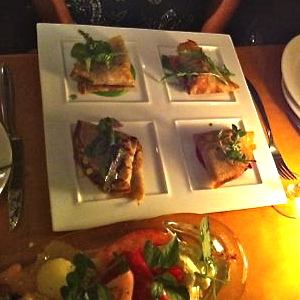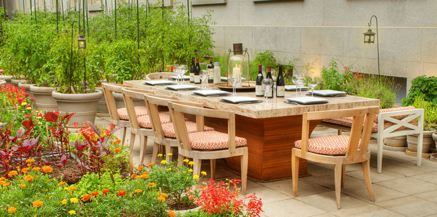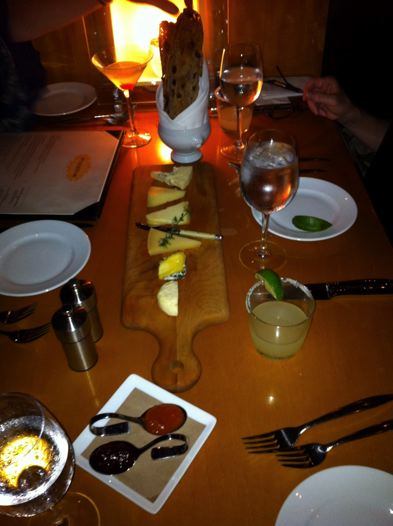Travel News
Behind-the-Scenes Green: Kimpton Hotels & Poste Restaurant, Washington, DC
 What makes a hotel truly green?
What makes a hotel truly green?
Is it not washing linens for a day or two? Placing recycling bins in the room?
Leslie Garrett, The Virtuous Traveler, wanted to find out what hotels are doing behind the scenes that most guests never even get to see.
In part two of her journey, she headed into the kitchen of Washington, D.C.’s Hotel Monaco.
Though many hotels are greening their ways, the Kimpton chain was a forerunner in the evolution of green hotels, particularly its Hotel Triton. The San Francisco Kimpton flagship, with its Eco-Celebrity suites forwarding a percentage of the room fee to various progressive and environmental groups in the 1990s, became something of a legend in the ecosphere.
So the chain has a lot to live up to, sustainably speaking. But, one would think, there’s a limit to how far a hotel–even a Kimpton–can go, given certain locales.
Which is why I was so surprised to retreat into an enormous urban garden, tucked behind Hotel Monaco, a Kimpton hotel smack in the hustle of Washington, D.C.
Get more tips on green travel in our Eco-Travel section.
The historic building (it opened in 1839 as the city’s General Post Office and is a National Historic Landmark) boasts soaring ceilings and classic architecture. And its location in Penn Quarter, walking distance to most of DC’s favorite spots, means that feet are the favored mode of transport.
 But it’s the food literally behind the hotel’s Poste Restaurant that takes this green boutique hotel a few steps beyond.
But it’s the food literally behind the hotel’s Poste Restaurant that takes this green boutique hotel a few steps beyond.
Chef Rob Weland is thrilled with his urban oasis, replete with its organic grapes, heirloom tomatoes, strawberries, asparagus, many herbs and much, much more. Weland, an avid cyclist who relies on two wheels to get to work, is a firm believer in a restaurant’s role in sustainable living, giving patrons a true taste of green eating… which to him means food that takes the shortest trip possible to our plates.
The garden is nourished by on-site composting (in 2009, Poste composted more than 40,000 pounds of food scrap) and tended by the entire kitchen staff, all of whom, Weland says, share his ideals. Indeed, the staff is active in two community garden projects beyond the hotel, teaching kids about growing food and giving them a chance to walk the talk.
More Behind the Scenes Green: Mansion House on Martha’s Vineyard.
 Staff members are also invited to make vinegars and preserves—whatever excites them and can be created from the garden’s bounty. The menu is simple, with many dishes consisting of only a few ingredients.
Staff members are also invited to make vinegars and preserves—whatever excites them and can be created from the garden’s bounty. The menu is simple, with many dishes consisting of only a few ingredients.
Welend insists it’s more challenging and rewarding to work with fewer ingredients— making it far more important that those ingredients be the freshest and best quality.
Menu items reflect the seasons, as well as what can be grown if not in the garden then at least nearby. They also reflect a growing intention to form community around food.
Poste Roasts allows guests to gather family-style on the backyard patio and enjoy a spit-roasted whole animal, complete with wine pairings.
Each Halloween (mark your calendar for October 30 or 31), Weland offers the Poste Ghost Roast, awarding dinner to the guests with the best costume (not required, but encouraged!).
Market to Market Dinners are another initiative that aims to get a group together–this time for an excursion to the Penn Quarter Farmer’s Market, where they shop for fresh produce, meet and chat with local farmers, then return to the restaurant where Poste staff create a meal from the group’s purchases. A biodynamic wine pairing is offered with each course.
Kimpton remains a pioneer in its green thinking ways, printing menus on recycled paper with soy-based ink, offering up biodegradable take-out products and adhering to Monterey Bay Aquarium’s Sustainable Seafood guidelines. Yet Poste’s commitment to food as an ingredient in creating a sustainable community—from farmer to chef to consumer—is what sets it apart among all the eco-trends of today.
By Leslie Garrett for PeterGreenberg.com. Leslie Garrett is an award-winning journalist and author of The Virtuous Consumer: Your Essential Shopping Guide for a Better, Kinder, Healthier World. Visit her at www.virtuousconsumer.com.
Related links on PeterGreenberg.com:
- Behind the Scenes Green: Mansion House on Martha’s Vineyard
- Capital Green: Washington, DC’s Eco-Tourism Cred
- Complete Guide to Washington, DC Vacations
- Eco-Travel section
- Packing With Purpose: Donating When You Travel
- Community-Based Tourism: Creating Authentic Travel Experiences
- Carbon Offsets: Travel With a Clean Conscience?












